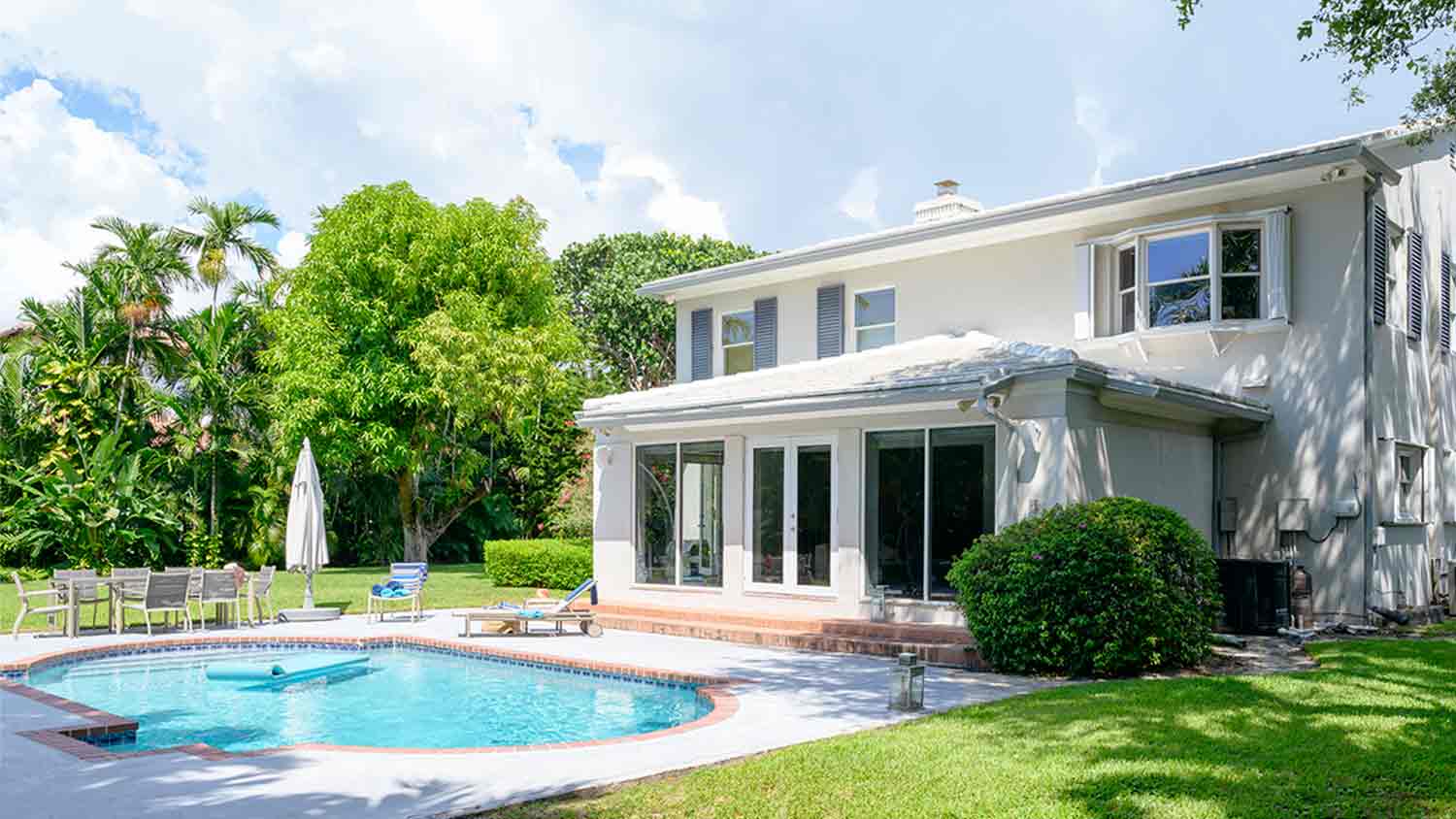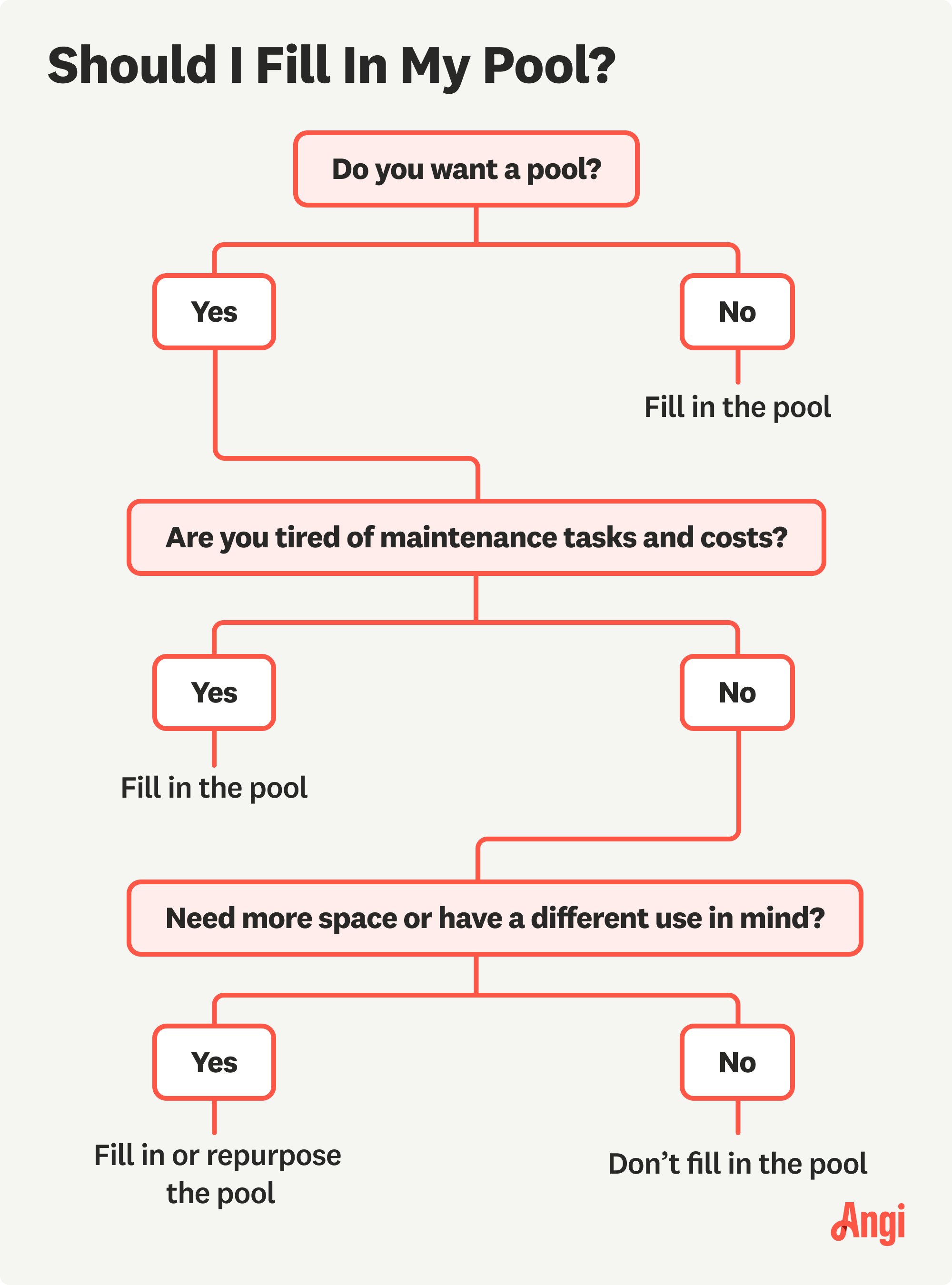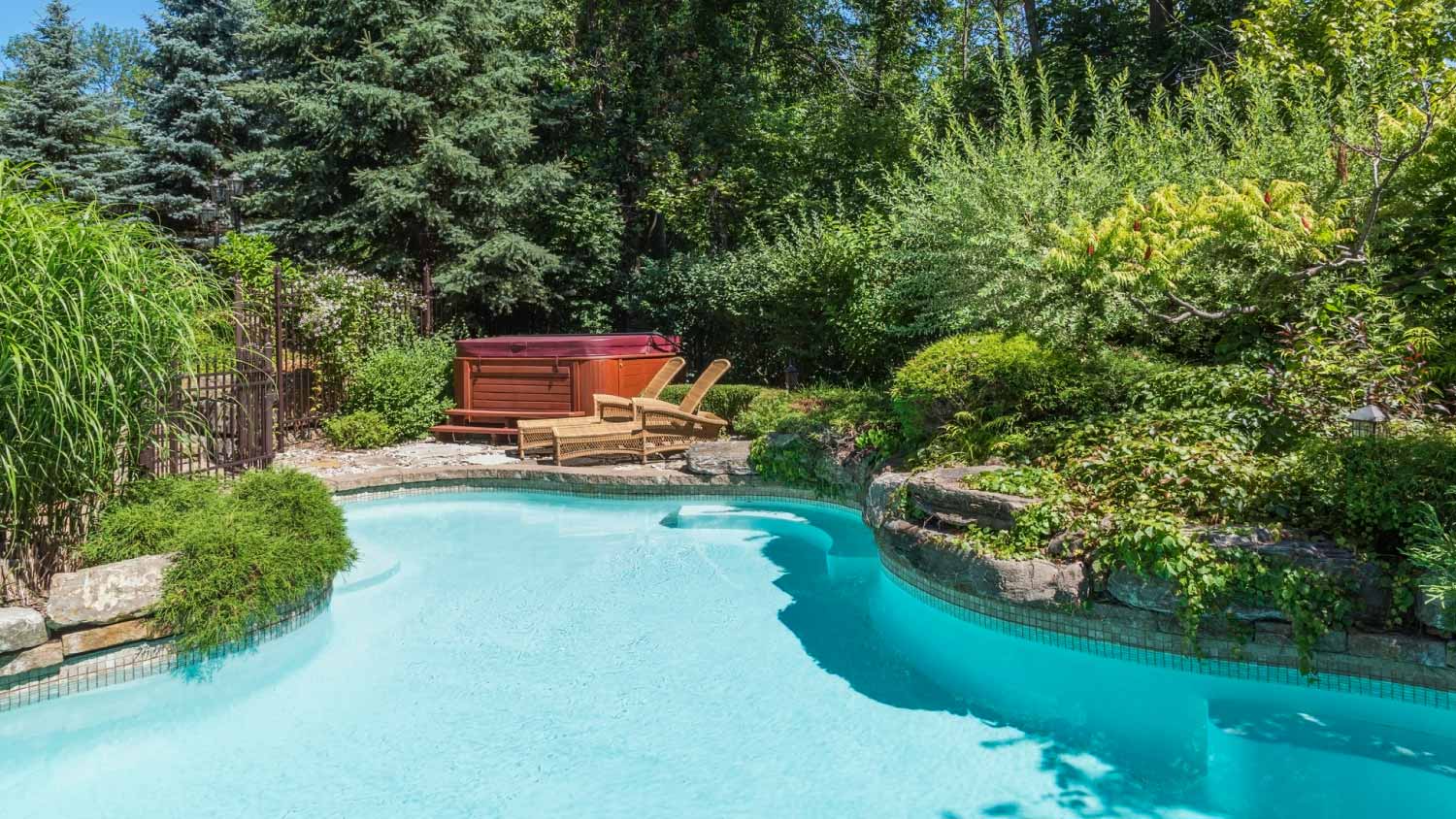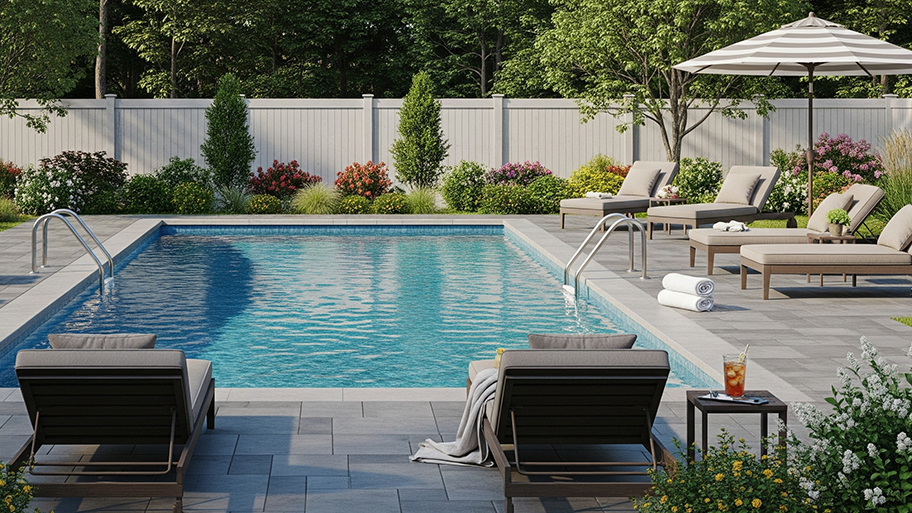
Fiberglass pools are a solid choice. If you are looking into installing one at home, read this guide to learn all the ins and outs of fiberglass pool costs.
Here’s the dirt on filling in your unwanted backyard oasis


Homeowners insurance rates are higher for homes with pools.
Filling in a pool can save hundreds on monthly maintenance costs.
In-ground pools have the potential to be a safety hazard.
In-ground pool repairs cost an average of $700 each.
Some in-ground pools add 5%–8% to a home’s value.
For some, a backyard pool is a source of fun and relaxation—but for others, it’s a high-maintenance feature they could live without. Reviewing the pros and cons of filling in a pool can help you decide whether to keep or ditch yours. Maybe repair costs and higher homeowners insurance premiums are worth it, or you might think of your pool as an expensive luxury and a potential safety hazard. Here are some factors to consider before investing in the cost of filling a pool with dirt.
The reasons to bury that backyard concrete pool range from saving money on insurance, maintenance, and repairs to eliminating the safety risks that a pool carries with it. Here are all of the advantages of filling in your pool.
While pools can be a source of comfort and relaxation, they also present a significant hazard to those who can’t swim. Pools cause nearly 400 drownings each year and are why drowning is the number one cause of death in young children.
Given those grim statistics, it's no wonder insurance companies see a swimming pool as a significant liability. Most charge higher homeowners insurance rates for homes with a backyard pool. That increase can be as low as $50 a year or as high as several hundred dollars a year, depending on the insurance company. By filling that pool in with dirt, you can fill your pockets with the money you save on your homeowners insurance.

Many people underestimate the cost of maintaining a pool, which can be pretty steep. If you pay a pool maintenance company, you’re likely forking over between $150 and $260 each month to maintain your pool, depending on its size and whether it’s salt water or chlorine. You’re also paying an additional $30 to $50 per month in utilities for running the pool’s pump for the required eight hours a day.
You can cut those costs down by doing it yourself, but you’ll still spend around $50 per month on chemicals (not to mention all the time you’ll be spending testing pool water, cleaning the pool filter, and adding chemicals).
You can eliminate those maintenance costs altogether and take back your free time if you decide to bury that pool.
If you’re a pool owner, you’re responsible for ensuring that it's safe for your family and any other swimmers. That’s because most jurisdictions consider the pool an “attractive nuisance,” a legal term that means the landowner is responsible for an object on their land that may attract a child, such as a pool.
That means if you’re a pool owner, you must fence it in and make sure the gate remains locked when it's not in use. Even when you’re monitoring a pool, there’s still the risk of slips and falls that can lead to injuries. Hiring a pool removal company near you to fill the pool with dirt eliminates that threat and the worry that someone could be seriously injured.
Swimming pools take up a significant chunk of your backyard real estate, with the average pool occupying some 600 square feet. That’s a lot of land to sacrifice, especially if your family only uses the pool occasionally. By filling it in, you can reclaim your yard for other purposes, such as a garden, play-set, deck, or patio.

While you might be shocking your pool when it needs a chlorine treatment, you’ll be shocked when it demands a costly repair. You can expect to pay around $700 for the average cost of swimming pool repairs.
The cost gets steeper when you need to replace equipment. The average pool pump lasts between eight and 12 years before you’ll need to replace it for $700 to $1,300. You can expect to replace the pool filter every five to seven years to the tune of $1,500 to $2,000.
Then there’s the potential for leaks in the plumbing, which can cost anywhere from $350 to $2,700 to fix. If you fill in your pool, you can avoid a hefty unexpected repair bill.
While some dream of owning a home with a swimming pool in the backyard, a swimming pool can make it harder to sell your home. Unless you live in a climate where pools are the norm, most potential buyers view them as a liability.
If your pool is poorly maintained or detracts from the yard’s aesthetics, it could be doing even more damage to your home’s value. While filling in a pool is a significant expense, it may be worth it if you're planning to sell your home in a market that doesn’t value these luxury items.
| Pros | Cons |
|---|---|
| Lower your homeowners insurance premium | Can detract from a home’s value |
| Eliminate monthly maintenance costs | Will cost thousands of dollars to fill it in |
| Alleviate safety concerns | Can restrict the use of the land |
| Will open up yard space | May require multiple fills as the dirt settles |
Given the cost of filling in a pool and potential restrictions on the land your pool occupies, there are also good reasons to consider keeping your pool. Here are the drawbacks to filling in your backyard watering hole.
You may save money in the long run by filling in an in-ground pool, but you’ll pay a lot up-front to do it. The cost of filling in a pool with dirt depends on the size and location. You can expect to pay an average of $5,000 for partial removal, where a pro removes part of the pool, collapses in the rest, and backfills it with dirt. If you want a full removal of the pool, expect to pay about twice that amount.
While you’ll eventually recoup that money in savings on homeowners insurance, pool maintenance, and utilities, it could take years to do so.

If you live in a warmer climate—such as Florida, Texas, or Southern California—chances are an in-ground pool is actually adding to the value of your home. If your in-ground pool is in good shape and you live in a warm region, it will add between 5% and 8% to the value of your home.
Given this added value plus the high cost of filling in a pool, it may make sense to keep the pool to avoid a financial loss.
Though your pool may be dead and buried, it can continue to haunt you with land use restrictions. Some cities restrict what you can and can’t do with the ground after you remove an in-ground pool.
Building codes may prevent you from building anything on the ground that was once the site of a pool, limiting its use to basic landscaping. Other municipalities vary these land use restrictions on whether you completed a full or partial pool removal. How you dispose of the pool could also impact the future sale of the home, as you’re required to disclose a partial pool fill-in to any potential buyers.
Whether you decide to remodel your pool or fill it with dirt comes down to one major question: Do you want a pool or not? If you love being able to jump into your pool and splash around on a hot day, but you don’t love how it looks, you can decide to remodel it to get it closer to your dream pool. However, if you’re tired of monthly maintenance or have safety concerns, then filling it in will be your best bet.
You should also factor in the cost of both projects. Pool remodeling costs between $5,500 and $15,000, but the actual cost depends on the extent of the remodeling, the size of the pool, and repairs. Filling in a pool costs between $2,500 and $8,500, depending on the size of the pool and the amount of dirt needed.

As with many decisions involving renovating your property, deciding whether to remove a swimming pool is a question of money, safety, and convenience. If the pool isn’t something your family uses, and you don’t live in an area where it adds value to the home, it may make sense to spend the money to fill it with dirt. This is especially true if you're concerned about the liability that comes with pool ownership or you’d like to stop paying for regular pool maintenance.
If you happen to live in a warm climate where pools are in demand, your pool is in good condition, and you don’t mind the safety concerns, it doesn’t make sense to spend thousands of dollars to remove something that adds value to your property.
From average costs to expert advice, get all the answers you need to get your job done.

Fiberglass pools are a solid choice. If you are looking into installing one at home, read this guide to learn all the ins and outs of fiberglass pool costs.

Don’t let broken pool lights keep you in the dark. Learn about pool light replacement costs, including unit prices, labor rates, and add-ons.

How much does it cost to fill a pool with water? It depends on the size of your pool and where you’re getting the water. This guide can help you budget.

A pool liner can protect your pool from leaks and improve its appearance. Learn more about the different types of pool liners and which is right for your pool.

How much shock does my pool need? Here's how to calculate how much pool shock to add to your pool based on its overall water condition.

Everything was going swimmingly, but now your pool heater is not working properly. Here are some troubleshooting tips to get you back in business.